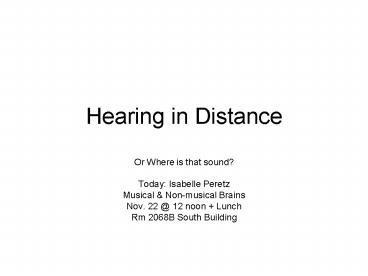Hearing in Distance - PowerPoint PPT Presentation
1 / 10
Title:
Hearing in Distance
Description:
Blindfolded walk to position or declare distance in Euclidean Units. When are people better? ... Sun, lamps. Light reflecting surfaces. Tables, faces, trees ... – PowerPoint PPT presentation
Number of Views:31
Avg rating:3.0/5.0
Title: Hearing in Distance
1
Hearing in Distance
- Or Where is that sound?
- Today Isabelle Peretz
- Musical Non-musical Brains
- Nov. 22 _at_ 12 noon Lunch
- Rm 2068B South Building
2
Improving Accuracy
- How do listeners judge distance?
- Metrics of perception
- Absolute distance objective scale
- Euclidean
- Egocentric distance metric in body relations
- Gibsonian (J.J. Gibson)
- Finding a source in distance (Russell, 2004)
- Experiment test distance of a sound source
- 1 - 15 meters
- Blindfolded walk to position or declare distance
in Euclidean Units - When are people better?
3
Results of Walk vs. Metric
- Greater accuracy with walking judgments
- Much less variability
- Overestimation of metric close distances
- Underestimation of metric long distances
- Why did we find this result?
4
Is It Just Experience?
- Judge Sound Source
- Walking
- Pull board
- Laying on stomach, walking on hands
- Metrical declaration
- Blindfold listening
- Full vision movement to source position
- Judge distances 2 30 meters
5
Results with the Crawl Experiment
- Walk Crawl very accurate
- Some underestimation at very long distances
- Much more variation with metric judgment
- Tendency for overestimation
- Golfers show improved accuracy judging metric
distance - No underestimation tendency at greater distances
with body-relevant units
6
The Affordance Paradigm
- Why are listeners better judging distances using
body-relevant actions? - Use of Affordances
- Gibsons simple idea
- World is perceived in action relevant units
- All perception evolved to support action
- Best perception when subjects interact with
environment - Affordances
- Action/body-relevant properties of the world
- Graspable, Eatable, Sitable, Walkable
7
Hearing the Silent World
- Localization
- Study of sound sources
- Sound producing objects relative to listener
- Are sound sources the basis of hearing?
- Visual world
- Light producing objects
- Sun, lamps
- Light reflecting surfaces
- Tables, faces, trees
- Can we detect sound obscuring/reflecting surfaces?
8
Hearing the Silent World
- Sound obstructing surfaces
- Diffuse sound field set behind sound attenuating
surfaces - Are listeners sensitive to position of surfaces?
- Test behavioral judgment
- Is the aperture large enough to allow passage?
- Ego-centric judgment facilitates accuracy
- Aperture size affects intensity, spectra
- Randomize intensities, sine wave signals
- Listeners can detect position of sound
obstructing surfaces
9
Elevation
- Height relative to listener
- How can this be determined?
- Interaural cues?
- Timing difference between the ears
- Mid-Saggital plane
- Loudness difference between the ears
- Absorption by head pinna
- Front-back confusions
- Pinna cues
- Forward, downward facing
- Partially resolve front-back errors
10
Distance
- How far away is a sound source?
- Interaural cues?
- Azimuth does not indicate relative distance
- Pinna cues?
- Slight-downward facing
- More distant cues higher in the perceptual plane
- Salient cues for distance
- Intensity
- Attenuation over distance
- Frequency dependent
- Unreliable indicator
- Reverberation
- Increase in number and lag of echoes
- DEMO































